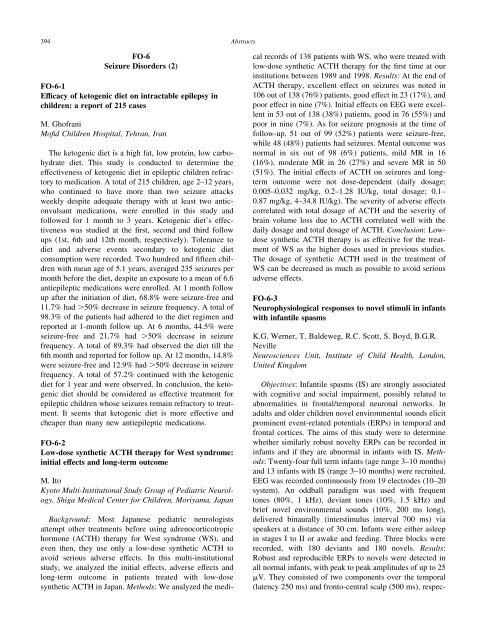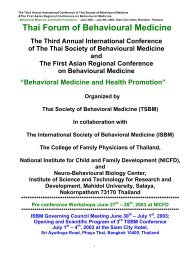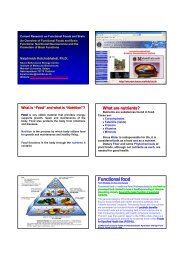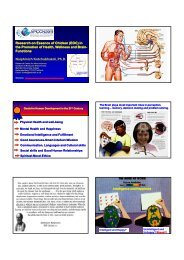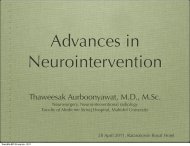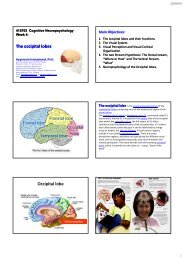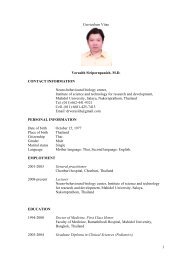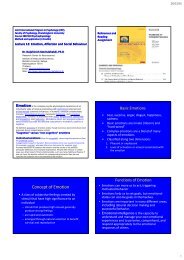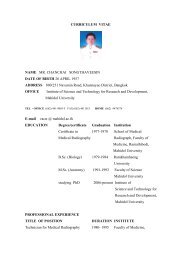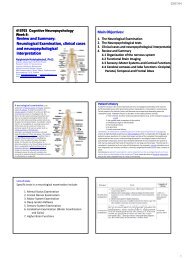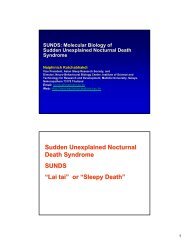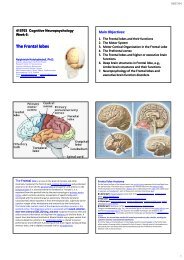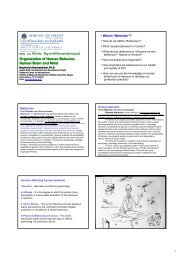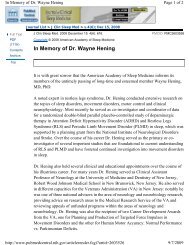PDF File - Mahidol University
PDF File - Mahidol University
PDF File - Mahidol University
Create successful ePaper yourself
Turn your PDF publications into a flip-book with our unique Google optimized e-Paper software.
394<br />
Abstracts<br />
FO-6<br />
Seizure Disorders (2)<br />
FO-6-1<br />
Efficacy of ketogenic diet on intractable epilepsy in<br />
children: a report of 215 cases<br />
M. Ghofrani<br />
Mofid Children Hospital, Tehran, Iran<br />
The ketogenic diet is a high fat, low protein, low carbohydrate<br />
diet. This study is conducted to determine the<br />
effectiveness of ketogenic diet in epileptic children refractory<br />
to medication. A total of 215 children, age 2–12 years,<br />
who continued to have more than two seizure attacks<br />
weekly despite adequate therapy with at least two anticonvulsant<br />
medications, were enrolled in this study and<br />
followed for 1 month to 3 years. Ketogenic diet’s effectiveness<br />
was studied at the first, second and third follow<br />
ups (1st, 6th and 12th month, respectively). Tolerance to<br />
diet and adverse events secondary to ketogenic diet<br />
consumption were recorded. Two hundred and fifteen children<br />
with mean age of 5.1 years, averaged 235 seizures per<br />
month before the diet, despite an exposure to a mean of 6.6<br />
antiepileptic medications were enrolled. At 1 month follow<br />
up after the initiation of diet, 68.8% were seizure-free and<br />
11.7% had .50% decrease in seizure frequency. A total of<br />
98.3% of the patients had adhered to the diet regimen and<br />
reported at 1-month follow up. At 6 months, 44.5% were<br />
seizure-free and 21.7% had .50% decrease in seizure<br />
frequency. A total of 89.3% had observed the diet till the<br />
6th month and reported for follow up. At 12 months, 14.8%<br />
were seizure-free and 12.9% had .50% decrease in seizure<br />
frequency. A total of 57.2% continued with the ketogenic<br />
diet for 1 year and were observed. In conclusion, the ketogenic<br />
diet should be considered as effective treatment for<br />
epileptic children whose seizures remain refractory to treatment.<br />
It seems that ketogenic diet is more effective and<br />
cheaper than many new antiepileptic medications.<br />
FO-6-2<br />
Low-dose synthetic ACTH therapy for West syndrome:<br />
initial effects and long-term outcome<br />
M. Ito<br />
Kyoto Multi-Institutional Study Group of Pediatric Neurology,<br />
Shiga Medical Center for Children, Moriyama, Japan<br />
Background: Most Japanese pediatric neurologists<br />
attempt other treatments before using adrenocorticotropic<br />
hormone (ACTH) therapy for West syndrome (WS), and<br />
even then, they use only a low-dose synthetic ACTH to<br />
avoid serious adverse effects. In this multi-institutional<br />
study, we analyzed the initial effects, adverse effects and<br />
long-term outcome in patients treated with low-dose<br />
synthetic ACTH in Japan. Methods: We analyzed the medical<br />
records of 138 patients with WS, who were treated with<br />
low-dose synthetic ACTH therapy for the first time at our<br />
institutions between 1989 and 1998. Results: At the end of<br />
ACTH therapy, excellent effect on seizures was noted in<br />
106 out of 138 (76%) patients, good effect in 23 (17%), and<br />
poor effect in nine (7%). Initial effects on EEG were excellent<br />
in 53 out of 138 (38%) patients, good in 76 (55%) and<br />
poor in nine (7%). As for seizure prognosis at the time of<br />
follow-up, 51 out of 99 (52%) patients were seizure-free,<br />
while 48 (48%) patients had seizures. Mental outcome was<br />
normal in six out of 98 (6%) patients, mild MR in 16<br />
(16%), moderate MR in 26 (27%) and severe MR in 50<br />
(51%). The initial effects of ACTH on seizures and longterm<br />
outcome were not dose-dependent (daily dosage;<br />
0.005–0.032 mg/kg, 0.2–1.28 IU/kg, total dosage; 0.1–<br />
0.87 mg/kg, 4–34.8 IU/kg). The severity of adverse effects<br />
correlated with total dosage of ACTH and the severity of<br />
brain volume loss due to ACTH correlated well with the<br />
daily dosage and total dosage of ACTH. Conclusion: Lowdose<br />
synthetic ACTH therapy is as effective for the treatment<br />
of WS as the higher doses used in previous studies.<br />
The dosage of synthetic ACTH used in the treatment of<br />
WS can be decreased as much as possible to avoid serious<br />
adverse effects.<br />
FO-6-3<br />
Neurophysiological responses to novel stimuli in infants<br />
with infantile spasms<br />
K.G. Werner, T. Baldeweg, R.C. Scott, S. Boyd, B.G.R.<br />
Neville<br />
Neurosciences Unit, Institute of Child Health, London,<br />
United Kingdom<br />
Objectives: Infantile spasms (IS) are strongly associated<br />
with cognitive and social impairment, possibly related to<br />
abnormalities in frontal/temporal neuronal networks. In<br />
adults and older children novel environmental sounds elicit<br />
prominent event-related potentials (ERPs) in temporal and<br />
frontal cortices. The aims of this study were to determine<br />
whether similarly robust novelty ERPs can be recorded in<br />
infants and if they are abnormal in infants with IS. Methods:<br />
Twenty-four full term infants (age range 3–10 months)<br />
and 13 infants with IS (range 3–10 months) were recruited.<br />
EEG was recorded continuously from 19 electrodes (10–20<br />
system). An oddball paradigm was used with frequent<br />
tones (80%, 1 kHz), deviant tones (10%, 1.5 kHz) and<br />
brief novel environmental sounds (10%, 200 ms long),<br />
delivered binaurally (interstimulus interval 700 ms) via<br />
speakers at a distance of 30 cm. Infants were either asleep<br />
in stages I to II or awake and feeding. Three blocks were<br />
recorded, with 180 deviants and 180 novels. Results:<br />
Robust and reproducible ERPs to novels were detected in<br />
all normal infants, with peak to peak amplitudes of up to 25<br />
mV. They consisted of two components over the temporal<br />
(latency 250 ms) and fronto-central scalp (500 ms), respec-


